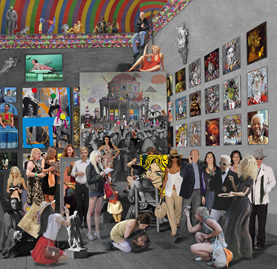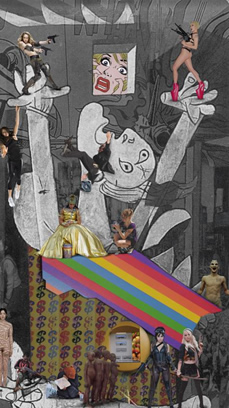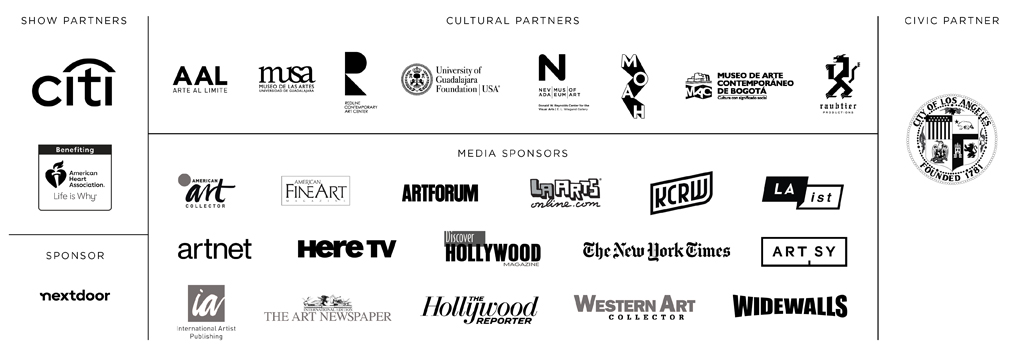Travelers in Time: The Fragility of the Historical Memory and Political Powers
Lluis Barba’s monumental photographs depict contemporary society using the same iconography as historical masterpieces. Each of his works is comprised of an ‘underpainting’ overlaid with contemporary visual references creating a symbolism and frame of reference that invite the viewer to navigate between the historical and ever changing contemporary celebrity driven landscape we live in. This unique exhibition is presented by Cynthia Corbett Gallery during the LA Art Show, January 27-31, 2016. The artist will also present a rare lecture on Saturday, January 30th at 2pm.
Barba’s exercises in reinterpretation are materialized in a body of work reminiscent of collage. Blurring historical boundaries Barba’s seminal work —a reimagining of Picasso’s ‘Guernica’— stands as the centerpiece, marking the first time the work will be shown in Los Angeles, following the artist’s solo museum show ‘Travels in Time’ at the Fundacio Vila Casas, Barcelona. A contemporary master of inventive storytelling, Barba successfully weaves art historical references and old master paintings seamlessly amongst art-world luminaries, celebrities, ordinary people, his friends, his collectors and, of course, iconic art works that we today value and readily recognize.
Barba’s exercises in reinterpretation are materialized in a body of work reminiscent of collage. Blurring historical boundaries Barba’s seminal work —a reimagining of Picasso’s ‘Guernica’— stands as the centerpiece, marking the first time the work will be shown in Los Angeles, following the artist’s solo museum show ‘Travels in Time’ at the Fundacio Vila Casas, Barcelona. A contemporary master of inventive storytelling, Barba successfully weaves art historical references and old master paintings seamlessly amongst art-world luminaries, celebrities, ordinary people, his friends, his collectors and, of course, iconic art works that we today value and readily recognize.

LLUÍS BARBA
The Studio of the Painter, Pierre Subleyras, 2012Edition of 6 C-Type Print
Perspex mounted 40.6 x 39.4 in
Courtesy of Cynthia Corbett Gallery

LLUÍS BARBA
Guernica, 2014 Edition of 6 CType Digital Print
Perspex mounted 58 x 119 in
Courtesy of Cynthia Corbett Gallery
The US has a remarkable affinity with Picasso’s ‘Guernica’ having been made custodians of the work at Picasso’s request. The safekeeping of the work was entrusted to the Museum of Modern Art (MoMA) in New York City. It formed the centrepiece of a Picasso retrospective at MoMA which opened six weeks after the Nazi invasion of Poland in 1939.
During the last twenty years Lluis Barba has developed his distinctive iconography, each work including visual references as people, paintings and his own artworks are transferred to new compositions. Just as artists have for centuries teased their audience with allegory and symbolism, so Barba’s jigsaw of iconogr aphy presents a maze of allegorical pathways, the symbolism of the historical sources overlaid with that of the contemporary characters, reinforced by our own personal knowledge and experience and the gravitas afforded by column inches, art criticism and saleroom prices. In Barba’s work we can read the growth of celebrity currency, commentary on recent history and also his own personal reflections: like many historical artists, Barba’s work is also ultimately a giant autobiography. We see photographs of collectors or visitors gathered from trips to international art fairs, including images he has been asked to take by people viewing his own work; there are his motifs such as barcodes, imprinted on his characters; and the rainbows and flowers, his symbols of hope.
In Barba’s Guernica (1937) Picasso (2013) that the myriad appropriations and commentary on the poverty and violence in the world becomes powerfully evident, as he uses as a backdrop the Picasso painting made in response to the 1937 bombing of Guernica. A series of cultural portals in the photographic collage invite you to roam and consume. The journey begins in the foreground as a mass of collaged children’s faces, displaced from various sites of conflict, carpet the ground. In a postmodern debate, Picasso’s blue period Poor people on the seashore (The Tragedy) (1903) is silhouetted against the hand of Picasso’s dying woman as Barba reminds us of the contemporary plight of refugees who risk perilous sea journeys to get to Europe, often drowning in the process. We glimpse Picasso again behind the Guernica bull, strolling on the beach holding a parasol above his lover Françoise Gilot in the famous 1948 Capa photograph, and again in a photograph of Maurizio Cattelan’s 1998 performance where an actor wore a comic-book Picasso mask to greet visitors as they entered New York’s MoMA. Motifs of violence fuse Barba’s collage together: a group of figures about to be shot, from Goya’s The Third of May 1808 (1814), shelter under the arm of a woman bearing instead of a lamp of hope, a crucified Christ strapped to a missile, from Barba’s previous work La Ronda de los Prisioneros. Van Gogh. (2011). Whilst Paris Hilton looks seductively at us resting against a gun and naval officers reappear from other Barba works in their summer uniforms with a colourful tulip motif; Barba’s pigs are led into the artwork by Koons’ kitsch Ushering in Banality (1988); and Samuel Keller is photographed on his last day as Art Basel Director. As meanings attach and aesthetic bridges are formed, Warhol is a constant reminder of fame and branding: we see his Dollar Sign (1981) printed on wallpaper and his 1982 purple Knives, whilst his 1966 Cow Wallpaper is echoed in a repeated pattern of The Laughing Cow cheese logos. Everywhere there is threat, but also hope: a tank is covered with flowers; a rainbow shoots towards an agonised woman; Angelina Jolie is an emissary of peace; and Yoda from Star Wars floats above the scene, a wise and powerful force. Barba’s fantastic visual world entices us into a hall of mirrors, where history is reflected in a postmodern simulacrum of contemporary life. Ultimately he believes that artists have a unique ‘platform to express themselves’ and this reminder is ever present in his extraordinary art.1
During the last twenty years Lluis Barba has developed his distinctive iconography, each work including visual references as people, paintings and his own artworks are transferred to new compositions. Just as artists have for centuries teased their audience with allegory and symbolism, so Barba’s jigsaw of iconogr aphy presents a maze of allegorical pathways, the symbolism of the historical sources overlaid with that of the contemporary characters, reinforced by our own personal knowledge and experience and the gravitas afforded by column inches, art criticism and saleroom prices. In Barba’s work we can read the growth of celebrity currency, commentary on recent history and also his own personal reflections: like many historical artists, Barba’s work is also ultimately a giant autobiography. We see photographs of collectors or visitors gathered from trips to international art fairs, including images he has been asked to take by people viewing his own work; there are his motifs such as barcodes, imprinted on his characters; and the rainbows and flowers, his symbols of hope.
In Barba’s Guernica (1937) Picasso (2013) that the myriad appropriations and commentary on the poverty and violence in the world becomes powerfully evident, as he uses as a backdrop the Picasso painting made in response to the 1937 bombing of Guernica. A series of cultural portals in the photographic collage invite you to roam and consume. The journey begins in the foreground as a mass of collaged children’s faces, displaced from various sites of conflict, carpet the ground. In a postmodern debate, Picasso’s blue period Poor people on the seashore (The Tragedy) (1903) is silhouetted against the hand of Picasso’s dying woman as Barba reminds us of the contemporary plight of refugees who risk perilous sea journeys to get to Europe, often drowning in the process. We glimpse Picasso again behind the Guernica bull, strolling on the beach holding a parasol above his lover Françoise Gilot in the famous 1948 Capa photograph, and again in a photograph of Maurizio Cattelan’s 1998 performance where an actor wore a comic-book Picasso mask to greet visitors as they entered New York’s MoMA. Motifs of violence fuse Barba’s collage together: a group of figures about to be shot, from Goya’s The Third of May 1808 (1814), shelter under the arm of a woman bearing instead of a lamp of hope, a crucified Christ strapped to a missile, from Barba’s previous work La Ronda de los Prisioneros. Van Gogh. (2011). Whilst Paris Hilton looks seductively at us resting against a gun and naval officers reappear from other Barba works in their summer uniforms with a colourful tulip motif; Barba’s pigs are led into the artwork by Koons’ kitsch Ushering in Banality (1988); and Samuel Keller is photographed on his last day as Art Basel Director. As meanings attach and aesthetic bridges are formed, Warhol is a constant reminder of fame and branding: we see his Dollar Sign (1981) printed on wallpaper and his 1982 purple Knives, whilst his 1966 Cow Wallpaper is echoed in a repeated pattern of The Laughing Cow cheese logos. Everywhere there is threat, but also hope: a tank is covered with flowers; a rainbow shoots towards an agonised woman; Angelina Jolie is an emissary of peace; and Yoda from Star Wars floats above the scene, a wise and powerful force. Barba’s fantastic visual world entices us into a hall of mirrors, where history is reflected in a postmodern simulacrum of contemporary life. Ultimately he believes that artists have a unique ‘platform to express themselves’ and this reminder is ever present in his extraordinary art.1
About the Artist:
Born in Spain and educated at the Escola Massana Centre d’Art, Barcelona, Barba has exhibited his work in the United States, Europe, Latin America and Canada. His work is held in major public collections and museums, such as the Artothèque d’Art Anekdota in Paris, Foundation Daniela Chappard of Caracas, Foundation Lluiś Carulla, L’Espluga de Francoli,́ Tarragona, Instituto Cervantes in Tangier, Morocco, Museo Jacobo Borges Caracas, Museo Marugame Hirai Japan, Museo de Arte Contemporań eo Wifredo Lam, la Habana, Museo Internacional Cairo, Egypt and Museu d’Art Contemporani de Barcelona. Private collections include, Jorge M. Pérez of Miami, Stuart & Pamela Rothenberg of New York, Rick & Kathy Hilton of Los Angeles and Wendy Fisher of London.
Lluiś Barba reworks iconic artworks to comment on contemporary society, introducing modern characters into Hyeronimus Bosch’s or Pieter Brueghel’s medieval scenes. His work leverages the language of artistic symbolism to critique both modern society and the art world. Utilizing society darlings such as Paris Hilton and Kate Moss, art world players such as Jay Jopling and music icons such as Lady Gaga and Rihanna, Barba expresses his debt to Art History and contemporary culture through a satirical and humorous slant.

